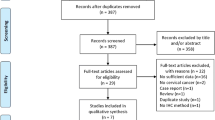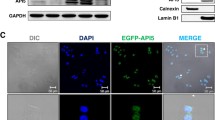Abstract
Objective
The objectives were to study the pattern of expression of PD-L1 in patients with carcinoma cervix and find out any relation with the various patient- and disease-related factors like histology, FIGO stage, lymph node metastasis and response to treatment.
Methods
One hundred cervical cancer patients registered during 2018 who were suitable for radical treatment were identified. The paraffin-embedded, formalin-fixed cervical biopsy specimens of these patients were collected. Immunohistochemical staining for PD-L1 expression was performed on the cervical biopsy material. The test was considered positive if 50 per cent or more tumour cells or less than 50 per cent with intense staining were present.
Results
PD-L1 was positive in 25 of 99 (25.3%) cervical carcinoma samples. PD-L1 was positive in 18 of 81 (22%) squamous cell carcinomas, 7 of 16 (43.7%) adenocarcinomas and 0 out of 2 adenosquamous carcinomas. Twenty-nine per cent of patients with positive pelvic nodes expressed PD-L1 positivity. None of the patients with paraaortic node metastasis expressed PD-L1 positivity. No statistically significant associations were found between PD-LI positivity and menopausal status, haemoglobin level, histology, tumour size, FIGO stage, nodal involvement and response to treatment.
Conclusions
One out of four patients had evidence of PD-L1 positivity in their cervical cancer. No association was found between PD-L1 expression and various clinicopathological factors and response to treatment. But follow-up studies are needed to observe any effect on disease-free or overall survival. Validation of scoring of PD-L1 expression and uniform reporting is required.


Similar content being viewed by others
References
Bray F, Ferlay J, Soerjomataram I, Siegel RL, Torre LAJA. Global cancer statistics 2018: GLOBOCAN estimates of incidence and mortality worldwide for 36 cancers in 185 countries. CA Cancer J Clin. 2018;68(6):394–424.
Patel S, Chiplunkar S. Host immune responses to cervical cancer. Curr Opin Obstet Gynecol. 2009;21(1):54–9.
Bosch FX, Lorincz A, Muñoz N, Meijer CJLM, Shah KV. The causal relation between human papillomavirus and cervical cancer. J Clin Pathol. 2002;55(4):244–65.
Herrington CS. Human papillomaviruses and cervical neoplasia. I. Classification, virology, pathology, and epidemiology. J Clin Pathol. 1994;47(12):1066–72.
Pandya PH, Murray ME, Pollok KE, Renbarger JL. The immune system in cancer pathogenesis: potential therapeutic approaches. J Immunol Res. 2016;2016.
Shiraki S, Yamada Y, Nakano T. Immunotherapy for uterine cervical carcinoma. Acta Obstet Gynaecol Jpn. 1979;31(11):2015.
Arends MJ, Buckley CH, Wells M. Aetiology, pathogenesis, and pathology of cervical neoplasia. J Clin Pathol. 1998;51(2):96–103.
Berrington De González A, Sweetland S, Green J. Comparison of risk factors for squamous cell and adenocarcinomas of the cervix: a meta-analysis. Br J Cancer. 2004;90(9):1787–91.
Reddy OL, Shintaku PI, Moatamed NA. Programmed death-ligand 1 (PD-L1) is expressed in a significant number of the uterine cervical carcinomas. Diagn Pathol. 2017;12(1):1–11.
D’Incecco A, Andreozzi M, Ludovini V, Rossi E, Capodanno A, Landi L, et al. PD-1 and PD-L1 expression in molecularly selected non-small-cell lung cancer patients. Br J Cancer. 2015;112(1):95–102.
Retz M, Bedke J, Herrmann E, Grimm M-O, Zimmermann U, Müller L, et al. 845OPhase III randomized, sequential, open-label study to evaluate the efficacy and safety of sorafenib-pazopanib versus pazopanib-sorafenib in the treatment of metastatic renal cell carcinoma (SWITCH-II). Ann Oncol 2017;28(suppl_5):1–2.
Carbone DP, Reck M, Creelan B, Horn L, Steins M, Felip E et al. HHS Public Access. 2019;376(25):2415–26.
Ferris RL, Licitra L, Fayette J, Even C, Blumenschein G, Harrington KJ, et al. Nivolumab in patients with recurrent or metastatic squamous cell carcinoma of the head and neck: efficacy and safety in checkMate 141 by prior cetuximab use. Clin Cancer Res. 2019;25(17):5221–30.
Mezache L, Paniccia B, Nyinawabera A, Nuovo GJ. Enhanced expression of PD L1 in cervical intraepithelial neoplasia and cervical cancers. Mod Pathol. 2015;28(12):1594–602.
Patel SP, Kurzrock R. PD-L1 expression as a predictive biomarker in cancer immunotherapy. Mol Cancer Ther. 2015;14(4):847–56.
Darb-Esfahani S, Kunze CA, Kulbe H, Sehouli J, Wienert S, Lindner J, et al. Prognostic impact of programmed cell death-1 ( PD-1) and PD-ligand 1 (PD-L1) expression in cancer cells and and tumor-infiltrating lymphocytes in ovarian high grade serous carcinoma. Oncotarget. 2015;7(2):1486–99.
Reck M, Rodriguez-Abreu D, Robinson AG, Hui R, Csöszi T, Fülöp A, et al. Pembrolizumab versus chemotherapy for PD-L1-positive non-small-cell lung cancer. N Engl J Med. 2016;375(19):1823–33.
Eb G, Na R. This trial protocol has been provided by the authors to give readers additional information about their work. Protocol for: Garon EB, Rizvi NA, Hui R et al Pembrolizumab for the treatment of non–small-cell lung cancer. N Engl J Med. 2018. https://doi.org/10.1056/NEJMoa1.
Karim R, Jordanova ES, Piersma SJ, Kenter GG, Chen L, Boer JM, et al. Tumor-expressed B7–H1 and B7-DC in relation to PD-1+ T-cell infiltration and survival of patients with cervical carcinoma. Clin Cancer Res. 2009;15(20):6341–7.
Enwere EK, Kornaga EN, Dean M, Koulis TA, Phan T, Kalantarian M, et al. Expression of PD-L1 and presence of CD8-positive T cells in pre-treatment specimens of locally advanced cervical cancer. Mod Pathol. 2017;30(4):577–86.
Heeren AM, Punt S, Bleeker MC, Gaarenstroom KN, Van Der Velden J, Kenter GG, et al. Prognostic effect of different PD-L1 expression patterns in squamous cell carcinoma and adenocarcinoma of the cervix. Mod Pathol. 2016;29(7):753–63.
Heeren AM, de Boer E, Bleeker MCG, Musters RJP, Buist MR, Kenter GG, et al. Nodal metastasis in cervical cancer occurs in clearly delineated fields of immune suppression in the pelvic lymph catchment area. Oncotarget. 2015;6(32):32484–93.
Gu X, Dong M, Liu Z, Mi Y, Yang J, Zhang Z, et al. Elevated PD-L1 expression predicts poor survival outcomes in patients with cervical cancer. Cancer Cell Int. 2019;19(1):1–9.
Wu P, Wu D, Li L, Chai Y, Huang J. PD-L1 and survival in solid tumors: a meta-analysis. PLoS ONE. 2015;10(6):1–15.
He J, Zhang Y, Kang S, Shen J, He J, Jiang L, et al. Prognostic significance of programmed cell death 1 (PD-1) or PD-1 ligand 1 (PD-L1) expression in epithelial-originated cancer: a meta-analysis. Medicine. 2015;94(6):e515.
Acknowledgements
Acknowledgements of research support: Intramural funding from RCC, Thiruvananthapuram 695011, India.
Author information
Authors and Affiliations
Corresponding author
Ethics declarations
Conflict of Interest
The authors declare that they have no conflict of interest.
Additional information
Publisher's Note
Springer Nature remains neutral with regard to jurisdictional claims in published maps and institutional affiliations.
Rights and permissions
About this article
Cite this article
Lathika, A.S., Lakshmi, S., Ramdas, P.T. et al. Programmed Death Ligand 1 (PD-L1) Expression in Cervical Cancer. Indian J Gynecol Oncolog 19, 86 (2021). https://doi.org/10.1007/s40944-021-00584-y
Received:
Revised:
Accepted:
Published:
DOI: https://doi.org/10.1007/s40944-021-00584-y




